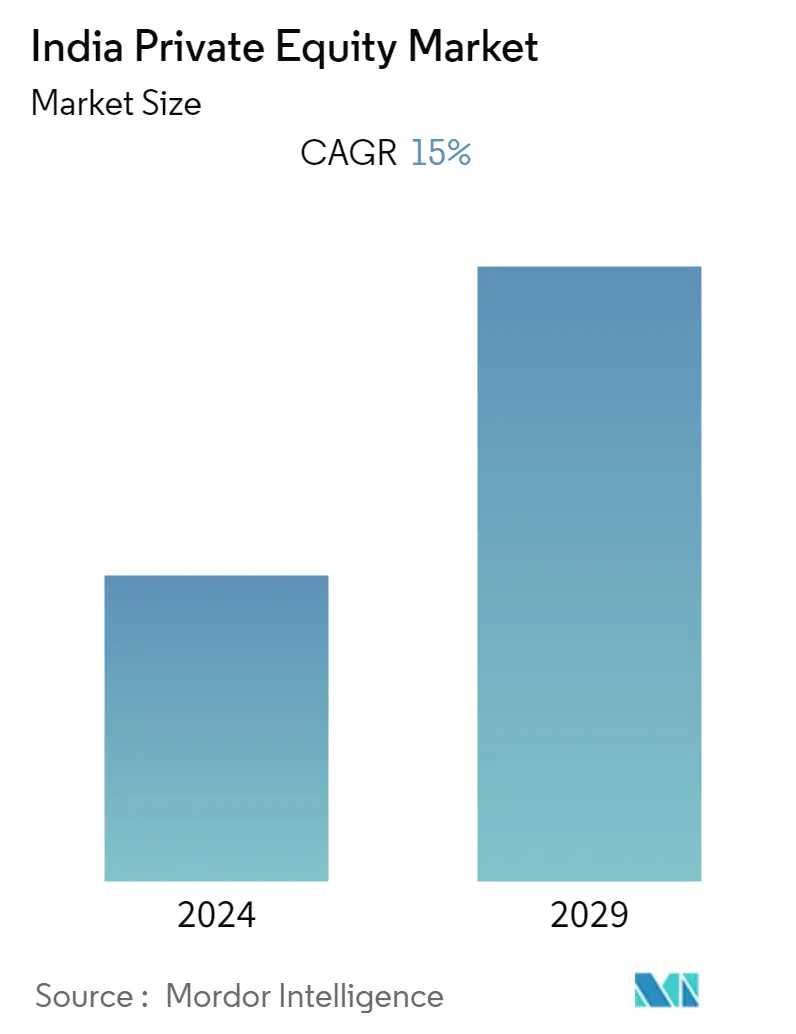Market Size of India Private Equity Industry

| Study Period | 2020 - 2029 |
| Base Year For Estimation | 2023 |
| Forecast Data Period | 2024 - 2029 |
| Historical Data Period | 2020 - 2022 |
| CAGR | 15.00 % |
| Market Concentration | Low |
Major Players/india-private-equity-market---growth,-trends,-and-forecast-(2020---2025)_Picture2.webp)
*Disclaimer: Major Players sorted in no particular order |
India Private Equity Market Analysis
The Indian private equity market is projected to register a CAGR of approximately 15% during the forecast period. The share of India in the global private investment market was valued at 2.2% during the period between 2015 and 2017. In 2019, significant investments in the infrastructure sector, which accounted for 35% of all private equity investments in India in 2019, provided momentum to the Indian private equity investment activity. The infrastructure sector witnessed rising demand for global buyouts and pension and sovereign funds. Furthermore, this trend is expected to remain strong in the near future. From a sector point of view, infrastructure (USD 803 million), real estate (USD 764 million), and financial services (USD 734 million) were the top three sectors, in terms of private equity investments, as of August 2019. Investments in the infrastructure and real estate sectors accounted for 35% of the total private equity investments in August 2019, as compared to 23% in August 2018. In 2019, the major deals included purchase of 9% stake in SBI Life Insurance by Carlyle Group, for about USD 652 million. This is one of Carlyle Group’s significant investments in India. Other significant deals included Baring Private equity purchase in NIIT Technologies and Brookfield Asset Management’s purchase of Pipeline Infrastructure. The infrastructure sector accounted for majority of the share in private equity investment, as of August 2019. Furthermore, Government of Singapore Investment Corp. invested in IRB Infrastructure's build–operate–transfer assets, for USD 622 million. Moreover, this deal is considered as one of the primary investments in the infrastructure sector, by a single sovereign wealth fund. The consumer tech and banking, financial services, and insurance (BFSI) remained the largest industrial sectors for investment, in terms of value. BFSI (banking, financial services, and insurance) remained the dominant industrial sector, with investments worth more than USD 5 billion in 2018. This was primarily driven by the rising class of non-banking financial companies (NBFCs), which impacted the growth of the ecosystem.
India Private Equity Industry Segmentation
This report aims to provide a detailed analysis of the Indian private equity market. Furthermore, it provides an overview of market dynamics, emerging trends in the segments and regional markets, and insights into various product and application types. Moreover, it provides an analysis of the portfolio of key players, along with the competitive landscape in the Indian private equity market.
| By Investment | |
| Real Estate | |
| Private Investment in Public Equity (PIPE) | |
| Buyouts | |
| Exits |
India Private Equity Market Size Summary
The Indian private equity market is experiencing robust growth, driven by significant investments in infrastructure, real estate, and financial services. The infrastructure sector, in particular, has been a major focus, attracting substantial investments from global buyouts and sovereign funds. This trend is expected to continue, with infrastructure and real estate sectors accounting for a significant portion of private equity investments. The banking, financial services, and insurance (BFSI) sector also remains a dominant area for investment, fueled by the rise of non-banking financial companies. The market's strength is reflected in the high value of deals and the confidence of investors, despite challenges in the broader Asia-Pacific region.
The landscape of the Indian private equity market is characterized by a mix of local and international players, with a fragmented structure. Key players such as Xander, Blackstone, and Brookfield are actively investing in the commercial real estate segment, capitalizing on developments like infrastructure status for logistics and 100% FDI in e-commerce. These factors, along with tax reforms like the Goods and Services Tax, have enhanced the investment climate in India's commercial real estate market. The focus on quality deals over quantity is evident, with a significant portion of deal value concentrated in a few major transactions. This strategic approach, coupled with an increase in buyouts, has bolstered the private equity market's growth prospects.
India Private Equity Market Size - Table of Contents
-
1. MARKET DYNAMICS
-
1.1 Market Overview
-
1.2 Market Drivers
-
1.3 Market Restraints
-
1.4 Porter's Five Forces Analysis
-
1.4.1 Threat of New Entrants
-
1.4.2 Bargaining Power of Buyers/Consumers
-
1.4.3 Bargaining Power of Suppliers
-
1.4.4 Threat of Substitute Products
-
1.4.5 Intensity of Competitive Rivalry
-
-
-
2. MARKET SEGMENTATION
-
2.1 By Investment
-
2.1.1 Real Estate
-
2.1.2 Private Investment in Public Equity (PIPE)
-
2.1.3 Buyouts
-
2.1.4 Exits
-
-
India Private Equity Market Size FAQs
What is the current India Private Equity Market size?
The India Private Equity Market is projected to register a CAGR of 15% during the forecast period (2024-2029)
Who are the key players in India Private Equity Market?
ICICI Venture, Chrys Capital, Sequoia Capital, Ascent Capital and Blackstone Group are the major companies operating in the India Private Equity Market.

